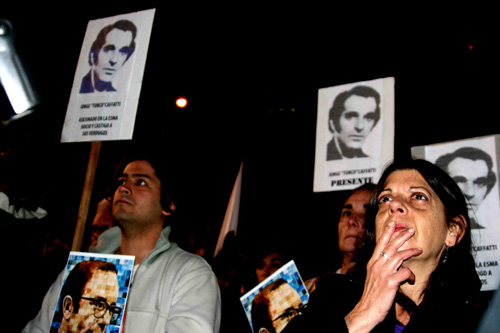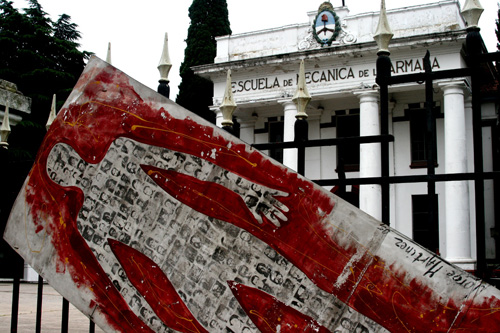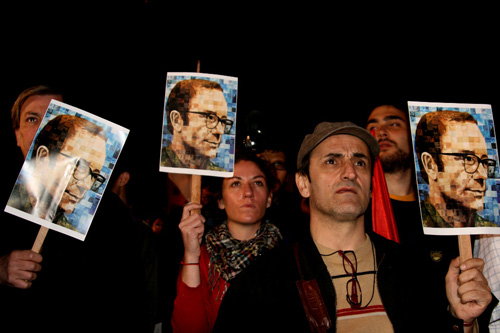
Due to the magnitude of the crimes and system of terror implemented at EMSA, the school has been described as Argentina’s Auschwitz. More than 5,000 people were disappeared at the ESMA, the country’s largest clandestine detention center in operation during the 1973-1983 dictatorship. Many of the victims were drugged and dropped into the sea from military planes.
Survivor Enrique Fukman describes the ESMA as a nexus of terror, “I was held kidnapped at the ESMA for 18 months; for 6 months I was hooded and tied up,” he told Toward Freedom. “The remaining time the officers used me for slave labor, they made us work or they would kill us.”
The Burden of Surviving
Outside of the courthouse on October 26, the day of the sentencing, hundreds celebrated as they watched the verdict being broadcasted on a large screen TV. Relatives, survivors and activists cried and screamed “assassin!” as the perpetrators heard their sentence. Many had mixed emotions about the verdict, especially torture survivors who have carried the burden of surviving and living without justice for more than 30 years.
“Today there’s mixed feelings, on one side there’s the celebration after struggling for so many years: next month marks 33 years ago since I was kidnapped. [It is important] that we could at least reach this point,” said Fukman. However, he lamented that so few perpetrators were sentenced for the murder of thousands of victims who perished inside the ESMA. “I feel rage that only two repressors are today on trial in connection with my kidnapping – as if only 2 individuals could have carried out all the crimes.” The trial investigated the disappearance of 86 individuals from the clandestine detention.
For many victims of this repression, the trial represented over 30 years of survival and providing testimony so that the perpetrators of the abuses would be put on trial. “I felt emotion that is still with me, because in some way the trial was a way for us to fulfill the mandate that they had given us: which was to get out and to denounce the crimes,” Lila Pastoriza, an ESMA survivor told the Argentine daily, Pagina 12. “As a survivor I have the satisfaction of fulfilling the mandate of those disappeared, the commitment of a generation that wanted to transform the country. The disappeared were those who the repressors tried to erase from history and our memory.” Survivors and lawyers have repeatedly faced threats and carried the burden of giving testimony.
Nexus of Terror

“I think this was a factor for the security forces of the Marines to successfully turn the ESMA into a machine to terrorize society, which is why the fight against impunity for the crimes at the ESMA has had an emblematic role,” said Pastoriza.
Hundreds of officers served at the ESMA Navy Mechanics School. While prisoners were tortured in the basement, insulated with egg cartons to drown out the cries of pain, officers socialized, ate and slept in the floors above. Victims were also held in the top floor, which resembled an attic. There, prisoners were tied up, hooded, and periodically moved for bathroom breaks or torture sessions. Inside the ESMA, the military set up a maternity ward for female prisoners who were held captive while pregnant. It is estimated that 200 babies were born at the ESMA’s maternity ward and taken from their mothers. The former military school was closed down in 2005 and converted into a museum documenting the crimes during the dictatorship, including the kidnapping of children born while their mothers were held captive.
Thirty years on, the former officers who now face charges unrepentantly defend their crimes and refuse to provide information that may lead to the true identity and location of the children, now in their 30s, who were kidnapped by appropriators with connections to the military. When Hector Febres, a former coast guard officer who faced trial for abuses carried out at the ESMA showed signs that he may betray the pact of silence, he was found dead in his jail cell from cyanide poisoning. His death has been investigated and Judge Sandra Arroyo Salgado has ruled that Febres was killed to keep him silent. The secrets from the military junta and the fate of newborn babies stolen from prisoners went to the tomb with Febres.
In the landmark trial investigating the crimes committed at the ESMA Navy Mechanics School, 12 former navy officers were convicted of kidnapping, torturing and killing leftist dissidents. The disappearance of Susana Engarola’s husband was one of the cases investigated in the trial. Engarola’s husband, Juan Carlos Ansorena was 28 when he was disappeared for his labor organizing activity at a Nestle plant in Buenos Aires. Engarola explained, “With our struggle we were able to take away the impunity. The officers being sentenced today enjoyed 30 years of impunity. The state had to change the laws that blocked justice for the crimes committed during the dictatorship. Today we are seeing justice.”
“However, only 300 officers are facing charges for abuses during the dictatorship, when that is the number of clandestine detention centers. Thousands participated in the crimes. Only the repressors who were seen by the small number who survived the concentration camps have been put on trial,” said Engarola. Many of the officers sentenced in the ESMA trial were indicted in the 1980s, but laws passed in the 1990s protected former security personnel from charges. Even with judicial roadblocks, human rights groups continued to push for investigations into the disappearance of tens of thousands. In 2005, Argentina’s Supreme Court overturned amnesty for the military.
Blonde Angel of Death
Alfredo Astiz, a lieutenant who served at the torture center was among those sentenced to life in prison. Astiz, also known as the blonde angel of death is most notorious for infiltrating the human rights group Mothers of Plaza de Mayo and coordinating the disappearance of two of the founding mothers.

The long standing impunity led many former military to believe that they would never be tried for their crimes. During the 1990s, military officials who had tortured and assassinated so called dissidents during the junta were often spotted at night clubs, vacation spots and high profile restaurants. In his final remarks to the court days before the landmark sentence Alfredo Astiz accused victims and their families of being paid to give testimony and said, “They don’t forgive us for having successfully fought subversion.”
Latin America’s Dark Past
Astiz and those sentenced were involved in the killing of political journalist Rodolfo Walsh. On March 23, 1977 on the first anniversary of the coup, Walsh published the Open Letter From a Writer To the Military Junta, where he broke the censorship and reported on the abuses that occurred at the time. Walsh’s letter would become one of the most famous writings about the crimes committed during the 1976-1983 military dictatorship. While he delivered the letter to various mailboxes in the capital, he was gunned down by a commando group. He was later taken to the ESMA Navy Mechanics School and his final whereabouts remain a mystery. His letter continues to be read throughout the world as the words of a writer “committed to give testimony in difficult times.” Walsh also highlighted in his letter that the abuses carried out by the junta were part of a regional plan to wipe out opposition to an economic model that created disparity, unemployment and poverty.
Leonel Curutchague, one of the human rights lawyers working on the ESMA trial, said that Argentina has set a legal precedent by defining the crimes committed during the military junta as systematic genocide and crimes against humanity. “The ESMA is one of the first mega-trials held,” Curutchague said. “Argentina should be proud of these trials, because they are an example of international legal precedent. We have set an example by trying repressors when the majority of them are still alive. Argentina is one of the few countries which have recognized the forced disappearance of individuals as a crime against humanity.”
Courts have just begun to scratch the surface of the magnitude of the genocide that took place with U.S. support in Latin America. However, Argentina has set an example for a region which shared dictatorial rule similar to that of Argentina.
On the same day of the ESMA verdict, Uruguay revoked amnesty for military officials who committed human rights atrocities during that nation’s 1973-1985 dictatorship. While justice has been slow for victims of dictatorships in Latin America, through the painstaking work of human rights activists, justice is now possible. Trials like the one dealing with ESMA have helped piece together a dark past which sends a reminder that no military can take honor in the torture, rape and murder of thousands. The trial also helps society overcome the fear of speaking out against a systematic genocide that aided in the spread of neoliberalism.
Marie Trigona is an independent journalist based in Argentina. She can be reached through her blog: www.mujereslibres.blogspot.com
